OxeFit XP1 Smart Gym review: elite fitness tech for maximum muscle mass
If the OxeFit XP1 smart gym were any smarter, I’d need a new exoskeleton just to keep up

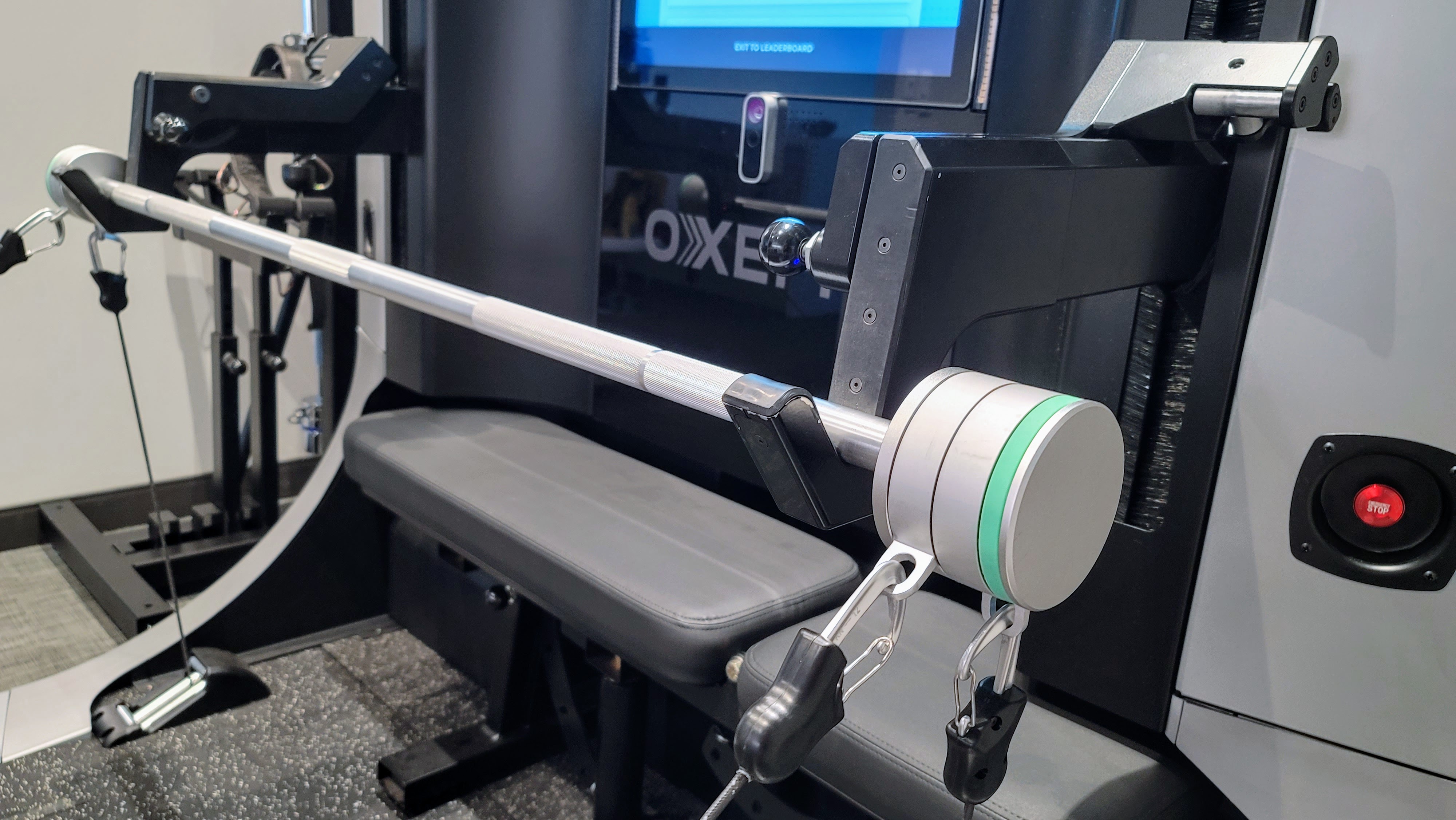
This ultra-premium (read: elite) personal training platform was built from the ground up for top-tier athletes – no matter the sport.
-
+
Rock-solid construction, all-in-one design
-
+
State-of-art adaptive weight resistance
-
+
Concentric / eccentric overloading
-
+
Dynamic perturbation training
-
+
Super-responsive force plates
-
+
Seamless exercise transitions
-
+
Integrated safety features
-
+
Built-in camera
-
-
Elite price point
-
-
Prohibitively bulky for smaller homes
-
-
Meant for pro athletes and coaches/trainers – not greenhorns
Why you can trust T3
In our OxeFit XP1 review, you'll find a clever combination of cutting-edge fitness tech that’s as futureproof as you are. A word of warning: the XP1 ain’t for greenhorns, and it literally embodies the phrase “you get what you pay for.”
OxeFit is the latest player to enter the smart gym game, and whereas the consumer-level XS1 was designed for the average athlete – albeit one with deeper-than-average pockets – the XP1 combines next-level engineering, robotics, artificial intelligence, movement tracking, body position capturing, advanced coaching, and predictive analytics to achieve a bonafide all-in-one fitness solution. When harnessed by the right humans (read: elite athletes and personal trainers), the OxeFit XP1 brings new meaning to the phrase “holistic health” with each and every hard-earned rep.
If you’re unfamiliar with the term “smart gym,” here’s the scoop: these high-tech machines are usually complemented by annual memberships to cover curated content, granting access to oodles of useful workout metrics after you hang up the towel. They often include a tower for storing dumbbells or plates (like the NordicTrack Vault or Tempo Studio), though competitors like Tonal and OxeFit house most moving mechanisms discreetly within the device itself. In short, every smart gym on the market today comes with its own flavor of personal training – and its own team of human coaches to boot.
Editor’s note: I spent roughly three full hours testing out the XP1, and am basing this review off those impressions – leveraged against other smart gyms I’ve evaluated in the past, including the OxeFit XS1, Speediance Gym Monster, NordicTrack Vault, Tempo Studio, Tempo Move, Tonal, and Kemtai.
OxeFit XP1 review: Specs
Live classes: No
Digital form tracking: Yes
Screen: 43-inch touchscreen (1920 x 1080)
Accessories: Barbell, pulldown bar, hand grips, ankle straps, waist harness, rope handle
Max Tension: 400 pounds
Size: 91.1 x 86.1 x 69.1 inches
Weight: N/A
Warranty: 3-year limited
OxeFit XP1 review: Price and availability
Let’s rip off this bovine-sized Band-Aid: unlike the OxeFit XS1 – whose hefty $3,999 starting price was already the highest I’d seen in terms of subscription-based smart gyms – OxeFit bumps that preliminary price point up to a whopping $40,000 for the XP1, which should give you an idea of their target audience: professional athletes/coaches, personal trainers, rehab facilities, and luxury fitness clubs, to name a few. Word of the day: elite.
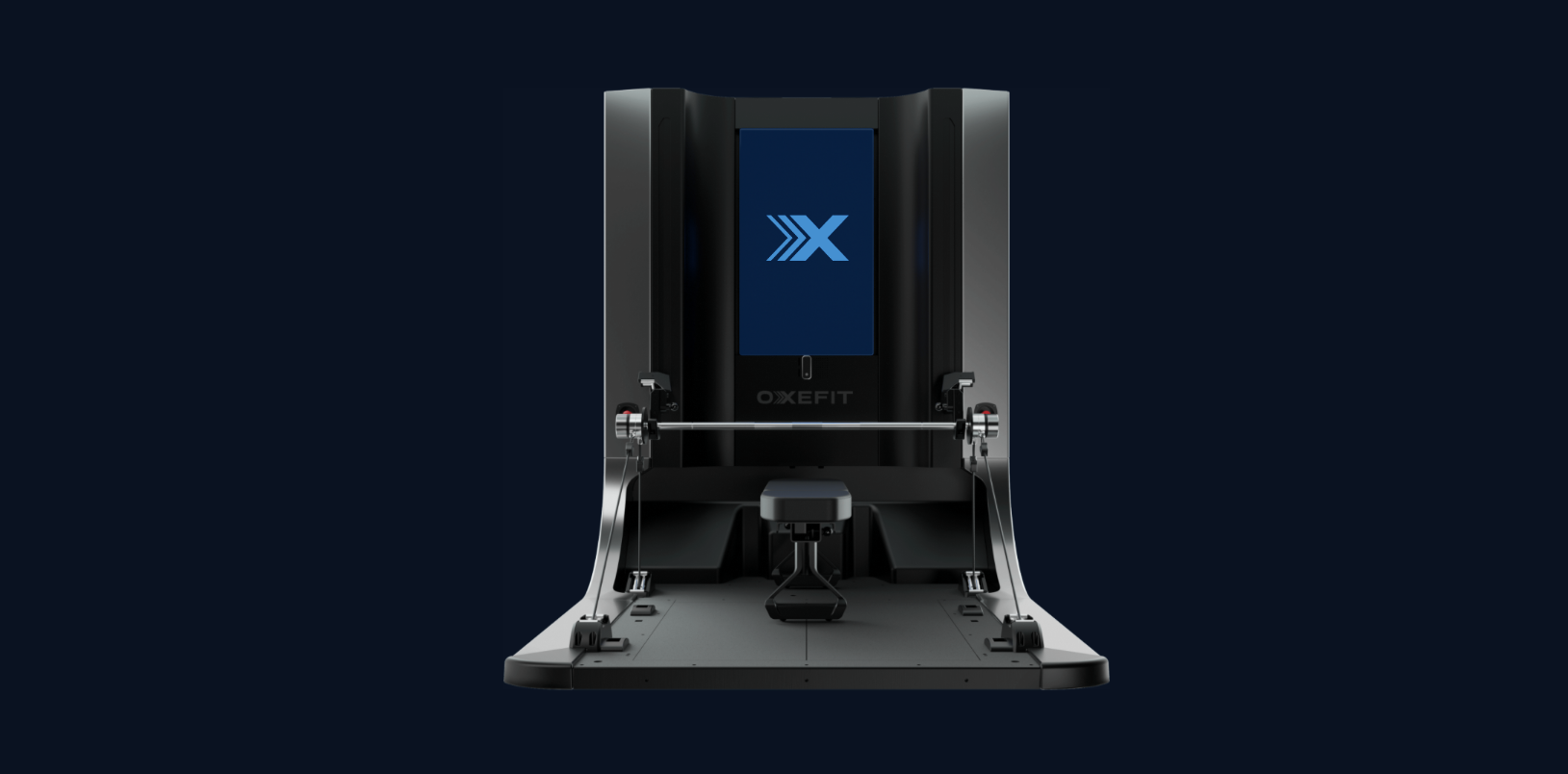
Just look at this best-in-class bad boy.
In fact, once you choose what size workout bar you’d like for the XP1, you’ll need to schedule an appointment for a full quote. (The lack of transparency is slightly frustrating, but still sensible for this tier of tech.) If you have the budget for this muscle-building monster, your clients are unlikely to be disappointed.
Another key difference between the XP1 and XS1: accessory and membership pricing. With the latter model, each accessory package – Flex ($549), Flow ($899), and Peak ($1,249) – is paired with a slightly steeper annual membership. With the ultra-elite XP1, however, your accessory package is presumably priced out during that initial consultation, and the OxeLead software – which is specifically meant for trainers instead of families – costs an additional $480 per year.
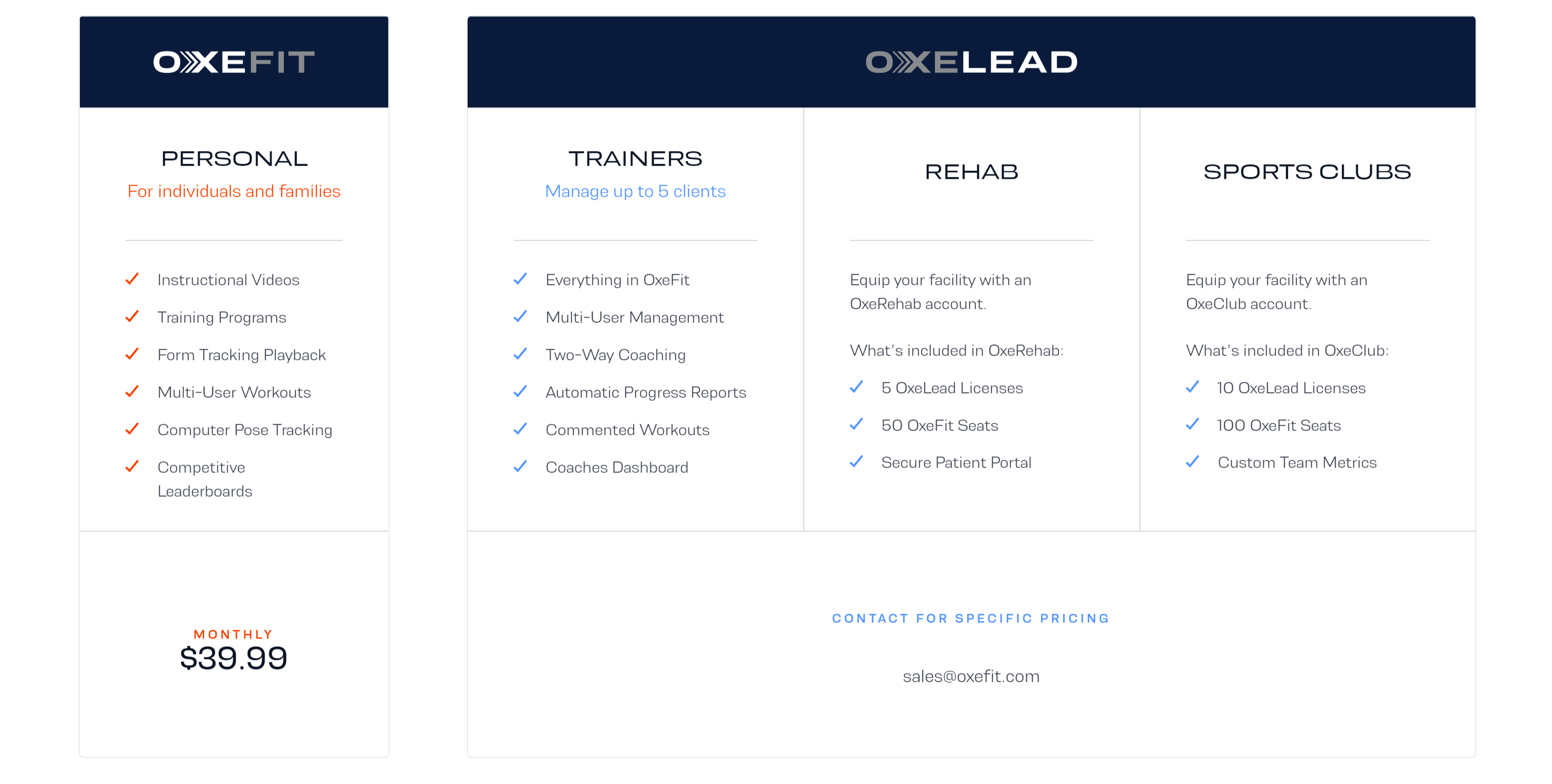
The OxeFit XP1 has unique software support on the backend.
Whereas several of the XS1’s accessories are specially designed to complement OxeFit’s dynamic collection of freestyle activities – SkiCross, SurfSwim, strength training, rowing, kayaking, canoeing, paddleboarding, and pilates – the XP1 targets serious lifters with a barbell, pull-down bar, hand grips, ankle straps, waist harness, and rope handle. If you already know your way around the gym, you’ll recognize these fitness tools in a nanosecond.
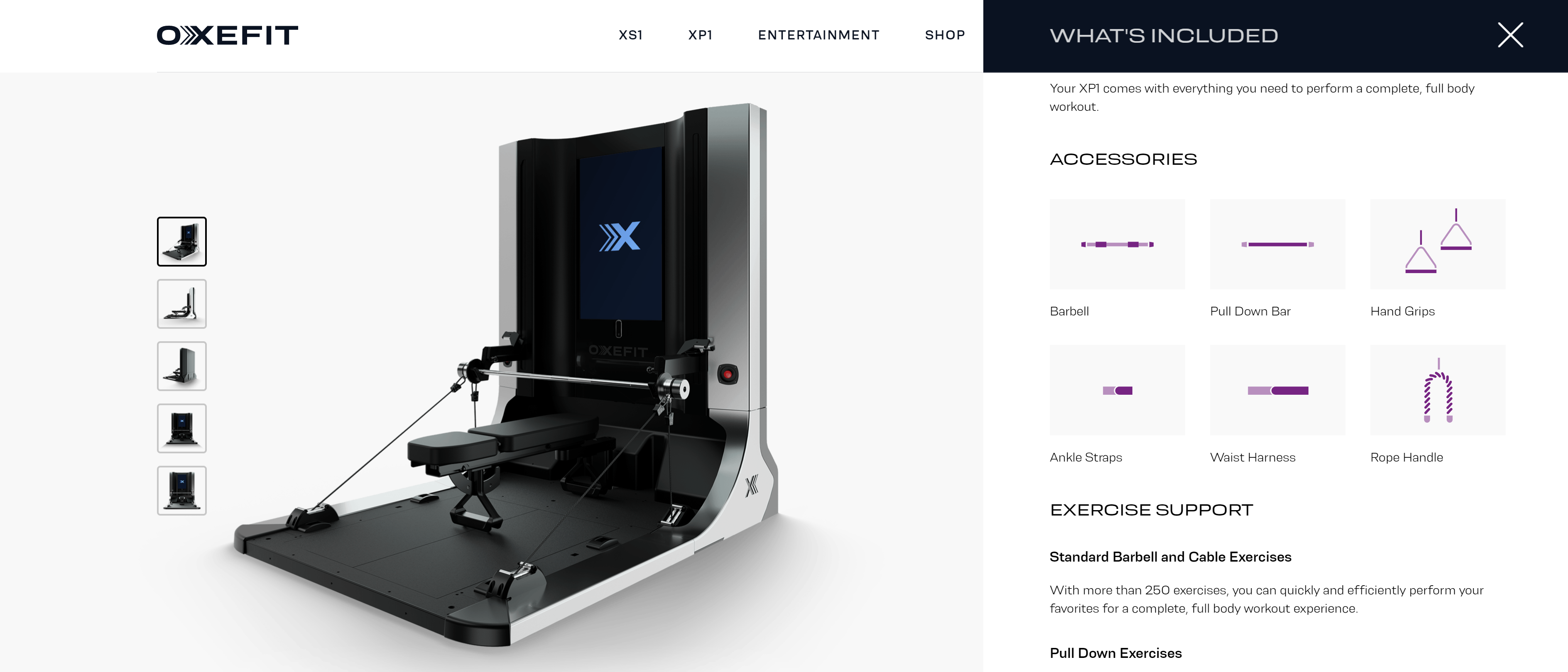
The OxeFit XP1 comes with all the gym rat essentials.
It might take some convincing for your boss to invest in an office filled with Terry Tates, but $40K sounds like a pretty easy sell to me. Best of luck.
OxeFit XP1 review: Setup and installation
Since my New York City abode is absolutely not equipped for the larger-than-life OxeFit XP1, I had to hoof it all the way to Plano, Texas for this review. (To see for yourself why the installation isn’t exactly a DIY project, check out this promotional video.)
Whereas OxeFit recommends a 6 x 8.5-foot area of clearance for the 300-pound XS1 – in addition to 4 inches of space behind the main unit, which folds up to 45.5 x 21.5 x 78 inches when not in use – the absolutely ginormous 91.1 x 86.1 x 69.1-inch XP1 is going exactly one place once assembled: nowhere.
Take note: just like the XS1, the XP1 is fully loaded with sensitive electronics, and it requires a climate-controlled environment to function properly. Sorry, bro, you can’t put this thing on your deck to impress the neighbors.
OxeFit XP1 review: Design
I appreciated the compact-yet-mighty construction of OxeFit’s consumer-level XS1, but the XP1 may as well have eaten its younger sibling for breakfast. (After a sensible protein shake, of course.) You essentially need an 8 x 8 x 6-foot area for this beastly behemoth, so do some measurements ahead of time, bucko.
Bulkiness aside, the XP1’s steel-and-aluminum construction feels as futuristic as it does rock-solid, and I’m not ashamed to admit this is the most intimidating piece of gym gear I’ve ever laid hooves (or hands) on. Especially once it was powered up.
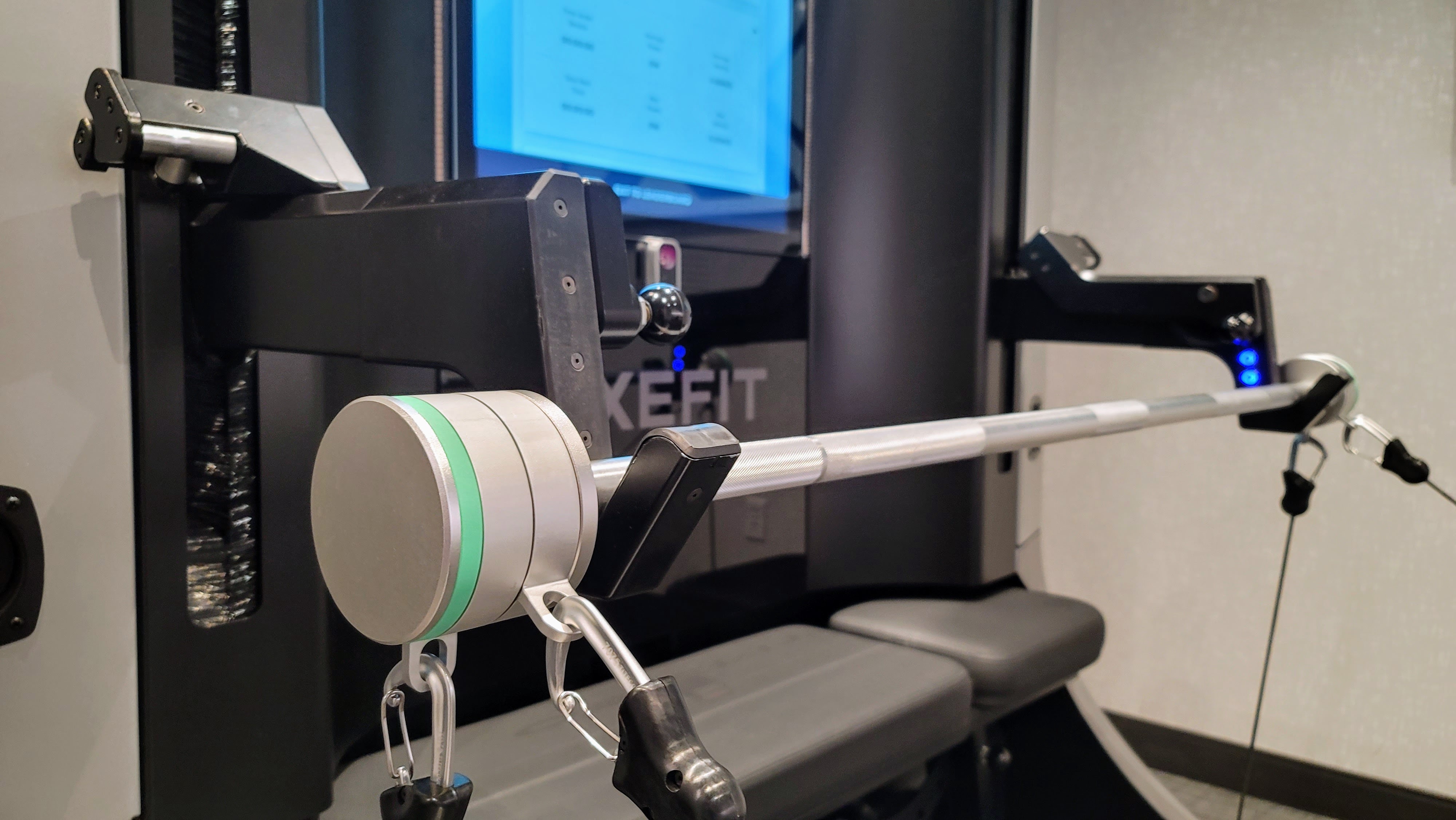
The OxeFit XP1 represents the future of fitness tech.
When I first feasted my eyes on Tonal’s beautiful 24-inch touchscreen, I was pretty impressed by its integration into the machine itself, which relies on a complex (and compact) system of digital mechanisms to adjust weight resistance. But then I feasted those same eyes on the OxeFit XS1’s 32-inch display, which instantly raised the bar even higher. “Surely this is as good as it gets,” I muttered to myself in between bicep curls.
But I was wrong. The OxeFit XP1’s glorious 43-inch touchscreen is the cream of the crop, giving me the best visual experience I’ve ever had with a smart gym. And it’s equipped with an obvious upgrade: an integrated camera that works in conjunction with the XP1’s force plates to track your form and assess imbalances as you go.
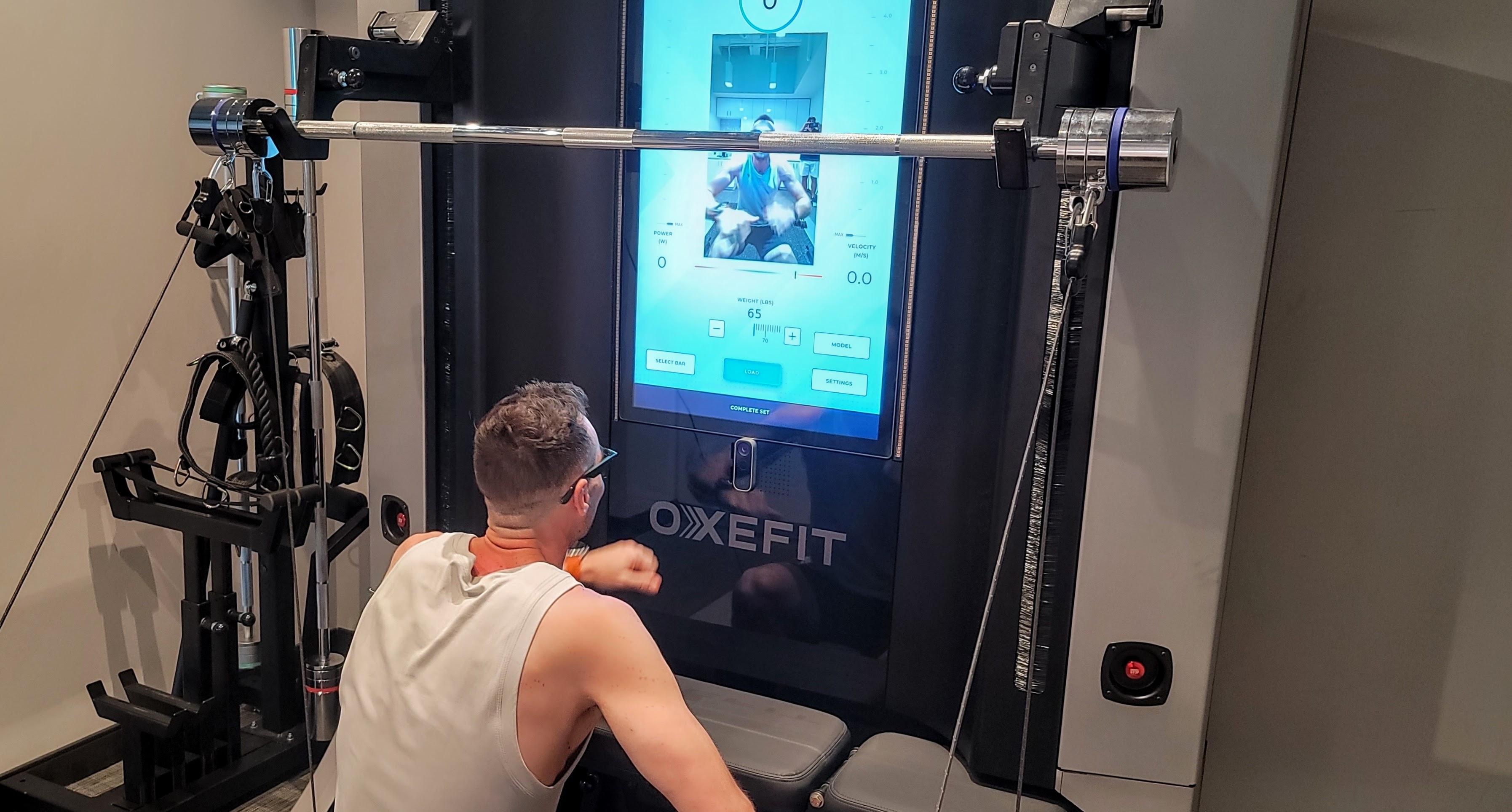
The OxeFit XP1 is an intimidating piece of fitness tech, to be sure.
There’s no folding option for the XP1’s workout deck – where the hefty 40 x 24-inch force plates reside – but the integrated weight bench swivels back and forth for easy access. You have to manually adjust the vertical cables on the XS1, while the XP1’s digital controls move the rack up and down with the press of a button. When combined with OxeFit’s adaptive weight resistance (up to 400 pounds), this essentially eliminated any need for a spotter – without giving me any excuses to lighten up my training load.
For pro athletes sick of constantly racking and unracking weights in between sets, the difference in time expenditure is potentially life-changing, to say the least. Plus, according to OxeFit, the XP1 takes up 80% less floor space than a traditional weight rack and its accompanying accessories. I’m *ahem* inclined to believe them.
The XP1’s dual force plates take things up a notch, letting athletes, physical therapists, and coaches zero in on individual pressure points, weakness indicators, and injury prevention. The integrated camera also provides more advanced analytics, allowing the XP1 to track your range of motion – including joint angles – in real time; you can toggle between Avatar and Mirror modes to monitor your body’s overall symmetry as you go. To quote investor Dak Prescott, “If you can track it, you can change it.”
The OxeFit team is constantly tweaking the accessories for their tech, and as mentioned above, the XP1 comes with a barbell, pull-down bar, hand grips, ankle straps, waist harness, and rope handle. There was a definite learning curve in terms of simply adjusting my body (and mind) to the machine itself – which gets smarter as you use it – but the entire platform is way more intuitive than I was expecting. After my initial tour of OxeFit headquarters with Darnell Jones and Rab Shanableh, I was treated to a three-hour XP1 session with Brett Bech, OxeFit’s director of strength-training protocol and former strength coach for the Dallas Cowboys.
Whereas the XS1 is meant for the semi-casual consumer, this coach-plus-athlete combo appears to be the ideal execution for the XP1, even if said coach is monitoring your progress from across the country. And while all those metrics are intimidating at first glance, any professional athlete could instantly combine their coach's interpretation of that data with their own to maximize daily training potential on the fly. Heck, the XP1 can even be adjusted for specific injuries, reducing potential recovery times by a sizeable margin.
OxeFit XP1 review: Display
That gorgeous 43-inch display is clearly the command center for the XP1, and a one-stop shop for OxeFit’s ever-expanding library of content, curated by professional personal trainers who talk the talk and walk the walk.
In the interest of flow – and to fully absorb the authentic OxeFit coaching experience – I let Brett do most of the touchscreen navigation during my tutorial, and was impressed with how easy it was to seamlessly transition from one muscle group to the next as we went along; the software is totally lag-free, and OxeFit does a great job of putting all the main controls at your fingertips. It’s a slightly different flavor than what you’ll find on the XS1, which felt very similar to iFit as I navigated from one workout selection screen to the next.
Akin to the XS1, the XP1 is both upgradeable and customizable; their dev team is constantly tweaking the software side of things to optimize your fitness experience. I’m rarely into the gamification of my workout routine, but as someone who’s been strength training on-and-off for the past 20+ years, it’s hard not to be impressed by all those juicy stats, and downright impossible not to literally visualize my future physiological progression.
Once you (or your coach) activate the resistance/load during each set, the XP1 keeps track of every rep on screen, paired with other contextually useful metrics such as power production, velocity, and overall symmetry; when you complete each workout, get ready for the ultimate data dump.
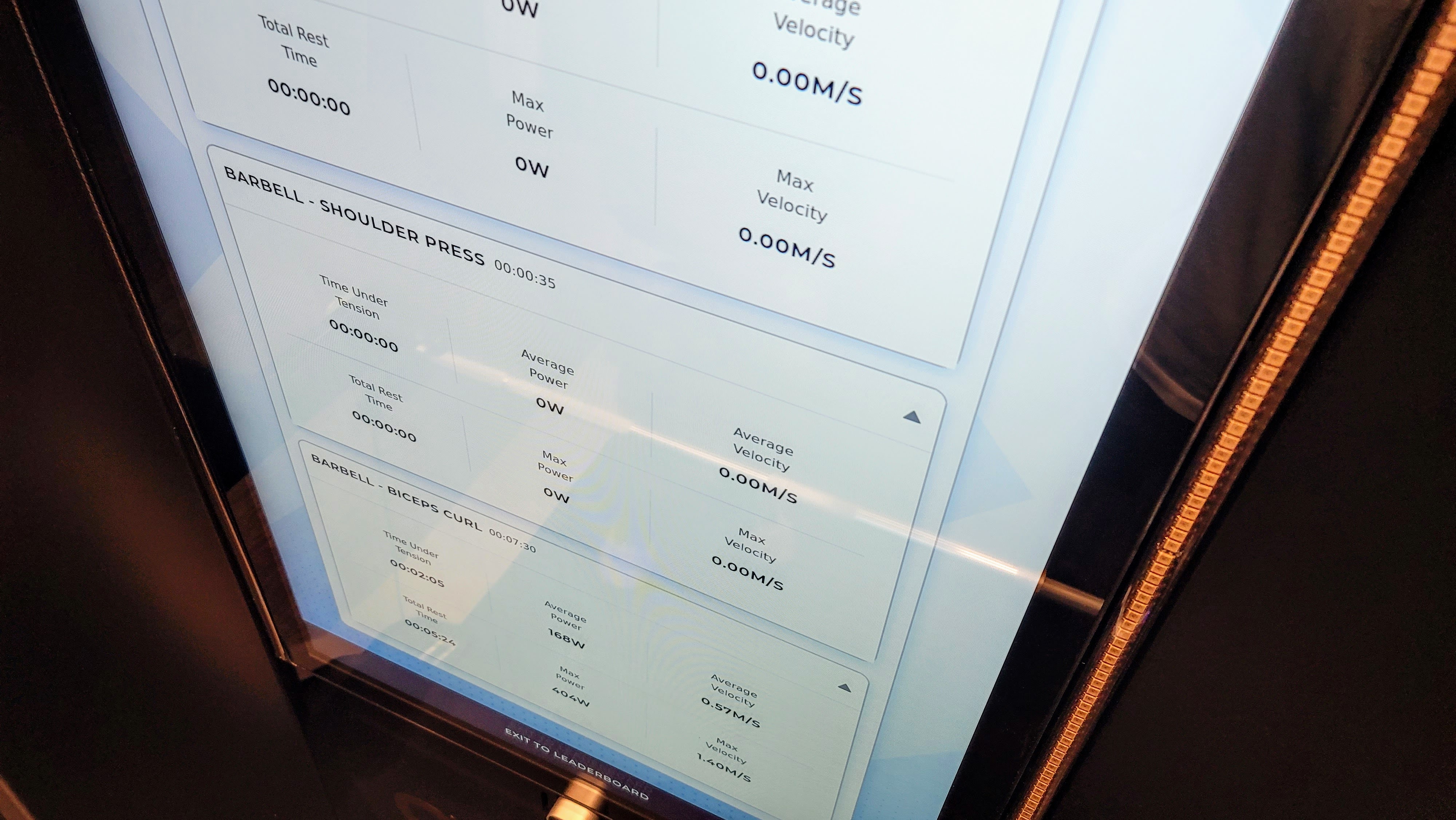
The OxeFit XP1 has the most comprehensive data collection I've seen to date.
When you combine the OxeFit XP1’s highly intuitive software with any human/s fully versed in the machine’s overall functionality, the possibilities are practically limitless. I can dig it.
OxeFit XP1 review: Inner tech
Some premium smart gyms like the Tempo Studio, Fiture, and Peloton Guide analyze your form with super-smart 3D sensors, but the OxeFit XP1 takes a different approach with those extra force plates underfoot to identify asymmetry in balance – and provide the appropriate onscreen feedback as necessary.
By integrating robotics, movement and performance tracking, and advanced coaching analytics into their machinery, the OxeFit team envisions the XP1 finding a home among professional athletes, military personnel, universities, and rehab clinics worldwide. This extra-comprehensive collection and analysis of data sets the OxeFit system apart, providing real-time feedback to complement your fitness goals on a holistically metric level. In short, when it comes to collecting and analyzing workout data and leveraging that data against your sport of choice, I haven’t tested anything more capable than the XP1, and the platform as a whole appears to be as futureproof as you can get right now in terms of all-in-one fitness solutions. Which is what I’d expect at this price.
OxeFit XP1: Performance
To get the full OxeFit XP1 experience, I completed a variety of pulse-pounding exercises including bench press, bicep curls, shoulder press, squats, and a few other core-crushing moves that put my whole body to work. As Brett guided me from one workout to the next, attaching and detaching the various accessories was easy enough, and OxeFit’s steel-and-aluminum mechanisms felt super secure whenever they locked into place.
Those dual force plates were even more sensitive than the XS1’s inner tech, and they did a great job of letting me know when my body symmetry was out of whack, even by the most miniscule of margins.
One feature unique to the XP1 is perturbation training, which creates randomized oscillations in the cables during barbell exercises. What does this mean, exactly? When I completed each rep, the machine would push and pull the bar in random directions without warning, forcing me to equalize the unexpected movements as I completed each squat. In short, it felt like some gym rat jerk was pushing me unexpectedly as I went along, which was...fun as hell, actually. But I’ll let this video speak for itself:
Another key feature: when activated, OxeFit’s adaptive weight resistance automatically provided concentric and/or eccentric overload throughout the entirety of each and every rep, allowing for maximum efficiency on the machine’s part – and maximum effort on mine.
As I progressed through several bench press sets, for example, the resistance stayed the same as I pushed the bar away from my chest, then increased as I lowered the bar back down. If you’ve ever done negative reps at the gym before, try to imagine that same burnout effect with an invisible spotter.
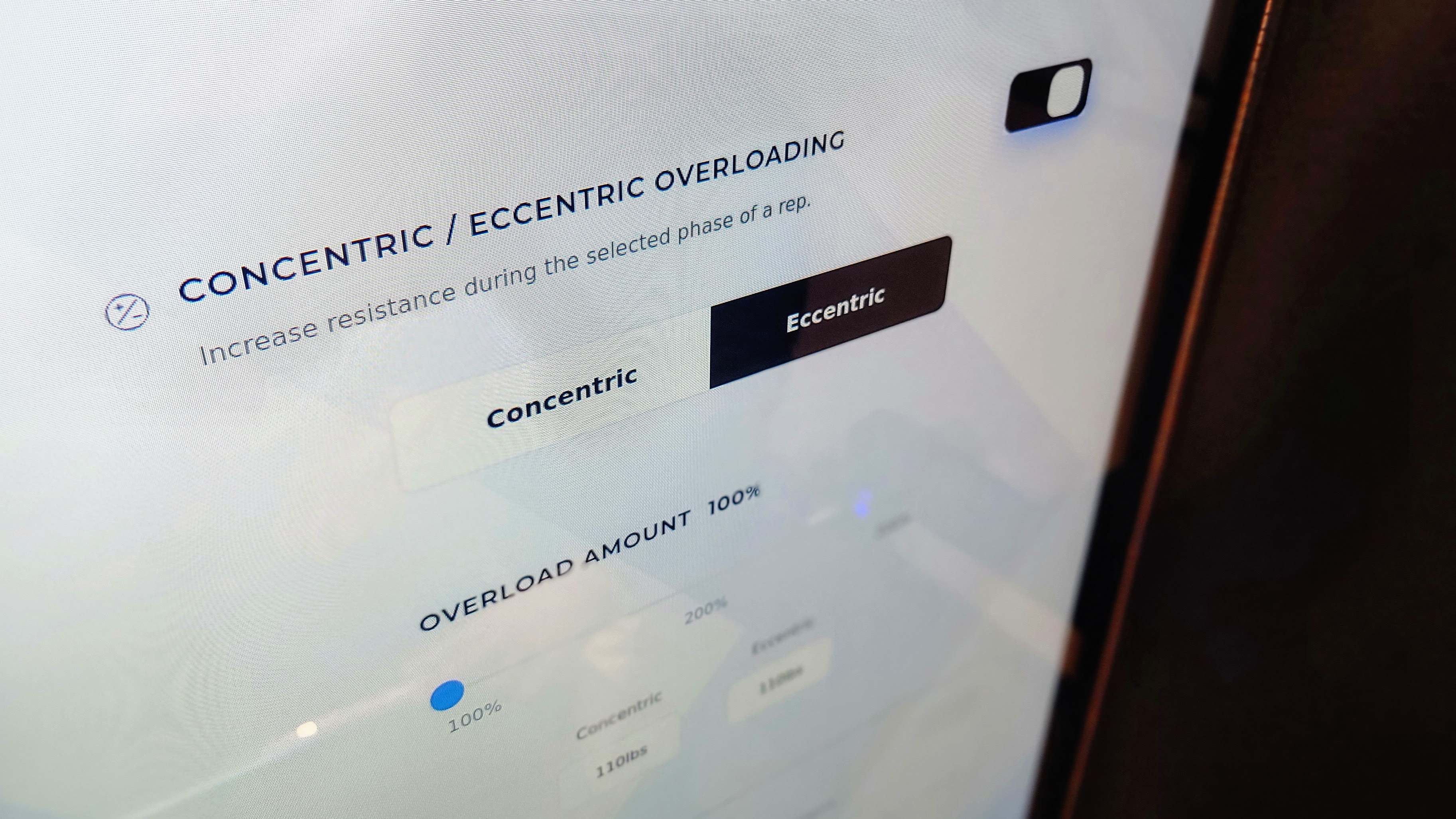
The OxeFit XP1 features both concentric and eccentric overloading for dynamic resistance training.
As long as we’re on the topic, OxeFit doesn’t skimp on safety features, and that includes a spotter mode. If the machine senses you tilt, rotate, or get pinned for more than a few seconds, the load is automatically negated until you get your form in order. This organically allows you to push yourself harder during solo workouts. You can’t put in the work if you’re constantly nursing one micro-injury after another, after all.
OxeFit XP1 review: Mobile content
As of this writing, there were 200+ strength-training exercises to complement the OxeLead app, which is designed for team-based management and data tracking. At the end of my tutorial, I really appreciated the wealth of data from the summary screen.
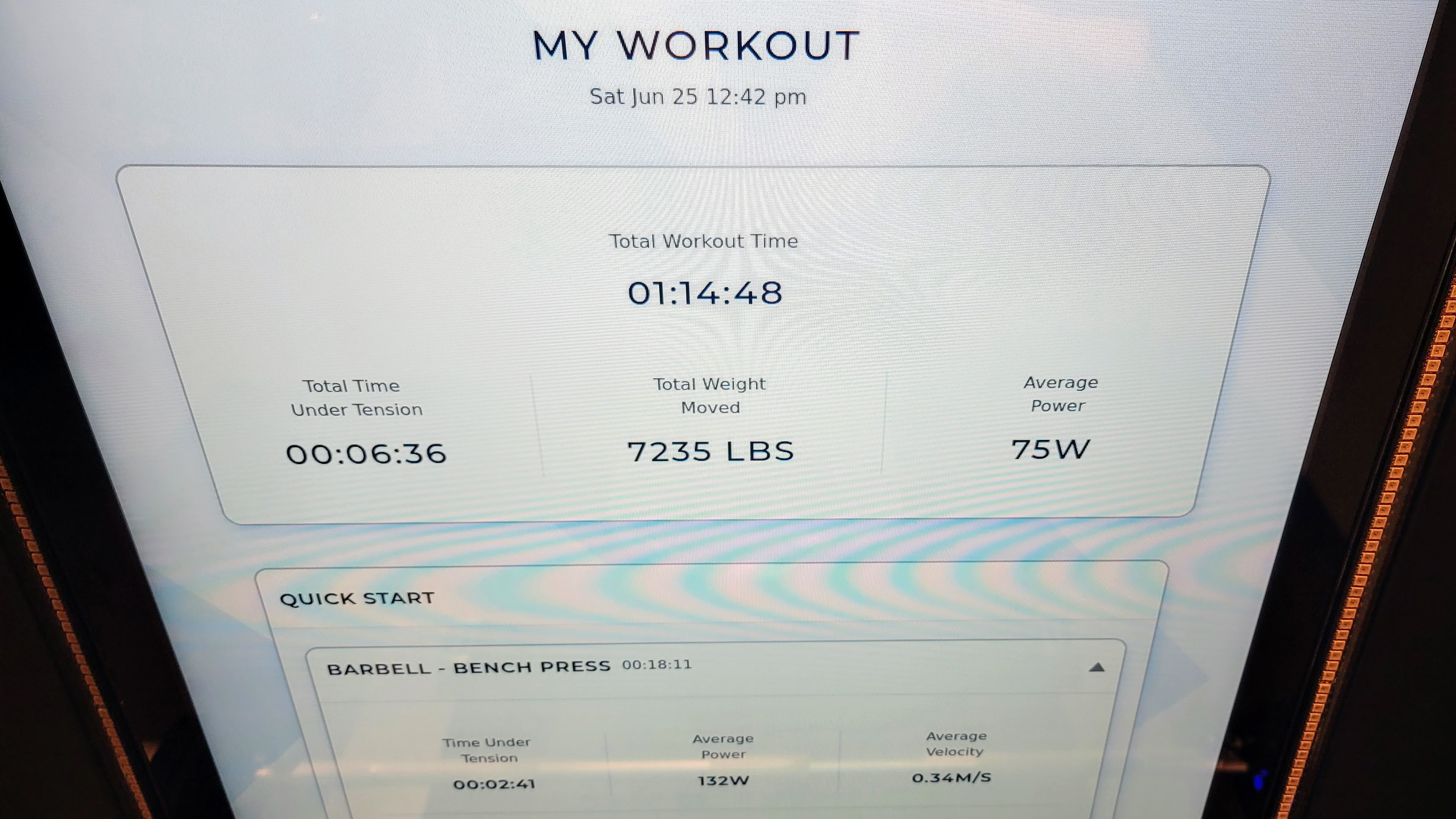
The OxeFit XP1 has every inch of data covered.
While I didn’t get the chance to test out the OxeLead app, this is where you and your coach can create custom fitness plans and access even more instructional, customizable content. Such progressive programs are backed by solid science, and thanks to global leaderboards and group workouts, you and your teammates can genuinely – and literally – motivate each other from afar. In short, once you own all the proper hardware, the sky's the limit in terms of firmware/software updates, upgradeable content, and additional data collection.
OxeFit XP1 review: Verdict
Until I took OxeFit for a spin, I touted Tonal as “one of the most dynamic workouts I’ve ever had.” Well, there’s a new contender in town, and it’s the XP1. When it comes to smart gyms, nothing else comes close.
In short, the OxeFit XP1 is the Ultron of futuristic fitness tech, and if you want to work out like an Avenger, this is the smart gym to beat. While the XS1 might be the best consumer-level smart gym I’ve tested to date, that goes double for the ultra-elite XP1, which is easily the most comprehensive fitness platform I’ve ever seen. I would have loved more time with the XP1 before offering my full assessment, but OxeFit definitely has the edge over its closest competitors in terms of AI-powered personal training and data-driven form tracking. (Including Tonal, which I tested for roughly the same amount of time, and in a similar manner.)
The price gap between the XS1 and XP1 might be wider than Dwanye Johnson’s chest, but if you happen to be reading this review, Dwayne, good news: you’re exactly the sort of customer OxeFit is looking for. Long-story-long: if you’re looking for the ultimate AI-powered fitness tool, look no further. The bar has been set.
OxeFit XP1 review: Also consider
The multiverse of fitness tech is downright saturated with all-in-one multi gyms right now, and at this point, OxeFit competitors like the NordicTrack Vault, Tempo Studio, Fiture, and Tonal have been around long enough to drop their original prices for the masses. Subscription-based fitness is here to stay, and it’s no longer a matter of asking can you replace your old gym membership, but should you?
If your abode meets the proper installation requirements, the Tonal smart gym costs $2,995, plus an extra $495 for the accessory package (with smart handles, smart bar, rope, bench, roller and workout mat). Not to mention $250 for installation and a $49 monthly membership. Looking for a mobile version of Tonal? Check out the Speediance Gym Monster.
On the opposite end of the spectrum, you can spend less than $1K on a good smartwatch and a quality set of adjustable dumbbells to maintain a solid strength-training routine on the cheap, and plenty of all-in-one multigyms are worth their weight in sweat. Kemtai ($40 per month) is another web-based fitness app that uses your device's webcam to track 44 different data points on your body – no extra equipment required.
On a budget? Consider more modest competitors like the Tempo Move ($495) or Peloton Guide strength trainer ($295), which both utilize AI tech to facilitate top-tier personal training right from your TV.
Sign up to the T3 newsletter for smarter living straight to your inbox
Get all the latest news, reviews, deals and buying guides on gorgeous tech, home and active products from the T3 experts

As a freelance journalist, TJ has over a decade of multi-medium storytelling under his belt. Leveraging a quarter century of collective coddiwompling amid the ever-evolving landscape of wireless gadgetry, his unique editorial background allows him to explore a variety of tech-centric subsectors on this fascinating planet. When he's not field testing new gear in the Catskills, Adirondacks, or an actual field, he can be found sipping Negronis in his living room and crafting Dr. Seussian poetry inside a tattered moleskin.
-
 Polar’s new subscription feature lands in the shadow of Garmin’s Connect+ rollout
Polar’s new subscription feature lands in the shadow of Garmin’s Connect+ rolloutPR genius or timing disaster? Polar’s new Fitness Programme adds adaptive training to its ecosystem
By Matt Kollat Published
-
 New Orient Star watches offer a glimpse of the magic within
New Orient Star watches offer a glimpse of the magic withinThere are two new skeleton pieces
By Sam Cross Published
-
 Netflix's most surprising 100%-rated sci-fi series returns with gorgeous trailer
Netflix's most surprising 100%-rated sci-fi series returns with gorgeous trailerLove Death + Robots is back for more
By Max Freeman-Mills Published